
views
Positioning your Body Correctly

Sit or stand in an upright, relaxed position. Hold your body upright and stand tall. If you decide to sit, make sure your back is straight so that you will be able to hold the flute in front of your body comfortably. Keep your body relaxed.
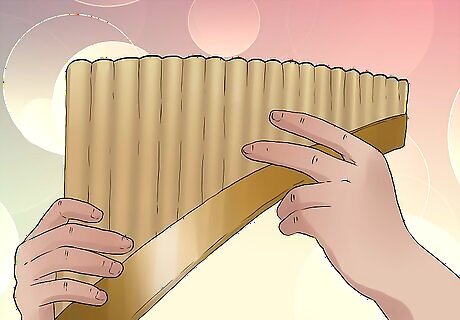
Hold the pan flute with both hands. Hold the long tube end of the flute in a handshake grip with your right hand. Position the flute vertically so that the tubes are parallel to your body. Use your left hand to gently hold the end of the flute with the short tubes. The pan flute is typically curved. Position the flute’s curve toward your body. Keep the pan flute horizontally aligned with your head. So if your head tilts one way or the other, the flute should also tilt to remain aligned with your head.
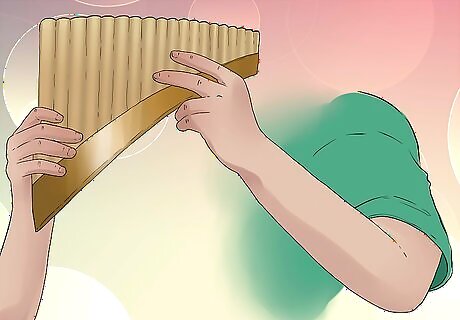
Relax your arms. Keep your arms relaxed as you hold the pan flute. This will allow you to easily move it back and forth so that you can blow into different tubes.

Form the correct embouchure. Your embouchure is the positioning and shaping of your mouth and lips in order to control your airflow when you play a pan flute. To form your embouchure, first make a slight smile and purse your lips a bit. Make a small opening between your lips. Position the pan flute against your bottom lip and direct air into the pipe’s tube, just like you would if you blew into a bottle. Move the bottom of the flute slightly away from your or closer to you to adjust the direction of the air flow into the tube. Adjust the position of the tube’s top higher or lower depending on your mouth and lips to produce a good quality sound. Tighten up your lips/embouchure when you are playing the higher notes (shorter tubes). Relax your embouchure when you play lower notes (longer tubes).
Trying Basic Playing Techniques
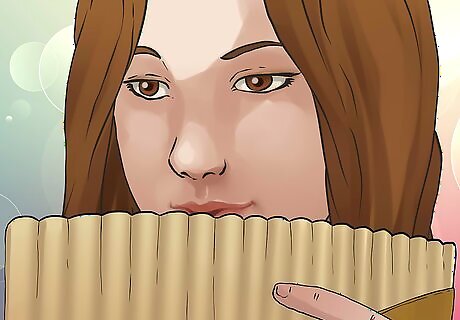
Blow air into the pan flute. Once your body is positioned correctly, you are ready to play the flute. Blow a steady, strong stream of air through your embouchure into one of the pan flute’s tubes. Make minor adjustments to your embouchure and the flute’s positioning so that you achieve the sound you want.

Pronounce different letters to make different sounds. When you blow air into the flute, you can alter the resulting sound by moving your tongue to pronounce different consonant letter sounds. The primary letter sound you use when playing a pan flute is a T sound. You can also make B, P, or D sounds to subtly change the pan flute sound.

Play half-notes on your pan flute. A musical scale has full notes (such as C, B, A) and half-notes (such as C sharp, E flat, and so on). The tubes on a pan flute produce full notes, but you can use different playing techniques to achieve half-notes and therefore expand the repertoire of music you can play. To play half-notes, try one of these techniques: Tilt the flute: Tilt the bottom of the pan flute away from you so that your lower lip covers part of the tube opening. Draw the flute down slightly against your lip at the same time. Retract your jaw: You can also retract your jaw to play half-notes. Pull your chin backwards while directing air into one of the tubes.
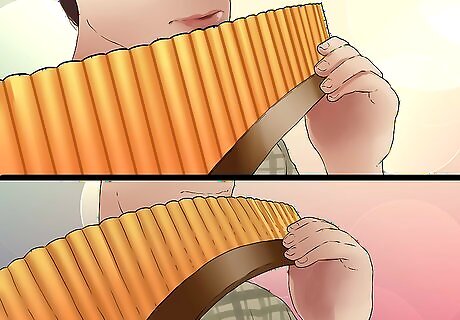
Bend notes on your pan flute. Bending notes are a way to add musicality and depth to your playing. A bent note is one sound that starts as a flat note sound and moves upward to land on the correct note, or a sharp note sound and moves downward to land on the correct note. To bend a note: Tilt flute away from your body to bend a note downward. Keep the airflow constant.

Play staccato notes. Staccato notes are short, almost sharp sounding notes. These are helpful especially when you are playing fast music. To play a staccato note, pronounce a sharp T sound, bringing your tongue to touch the back of your front teeth quickly.
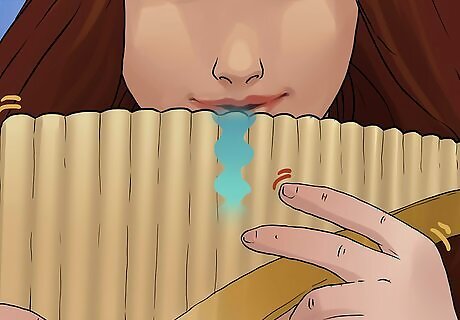
Create a vibrato sound. A vibrato is a wavering sound that adds dimension to your playing. Change the strength of the air flow into a tube from strong to weak over and over to add a vibrato, or wavering, sound., You can also get a vibrato sound by moving the pan flute towards and away from your mouth just a slight distance. Do this quickly while keeping the air flow consistent and strong.
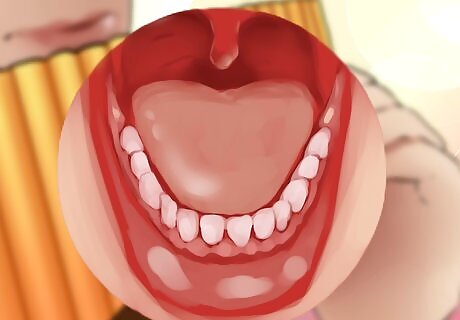
Flutter your tongue while you play. Fluttering your tongue will create a trilling sound when you play. To do this, vibrate your tongue like a purr or a rolling R. Maintain a strong stream of air across the tube of the pipe.
Practicing your Skills

Practice playing scales. A musical scale is a set of notes that ascend in order. They can vary depending on the key in which you play. A common scale starts with C and goes up to the next C (C, D, E, F, G, A, B, C). Play each note as a separate, clean note. Practice different techniques while moving up and down the musical scale, working on staccato sounds and vibrato sounds. Practice a scale with half-notes. On each tube, play the regular note and then play the half note by tilting the flute toward or away from your body.
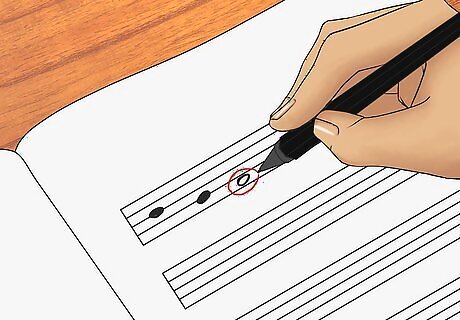
Practice playing simple songs. Simple songs such as “Mary Had a Little Lamb” will help you learn how to move between different notes and practice different techniques. Playing on a panpipe with 8 pipes, imagine every pipe is numbered 1 to 8. With the pipe up to your mouth, imagine each pipe has a number. The longest pipe is number 1, with each successive pipe as 2, 3, and so on. The shortest pipe is number 8. Play “Mary Had a Little Lamb” by blowing into the pipe that corresponds to each number: 3, 2, 1, 2, 3, 3, 3, 2, 2, 2, 3, 5, 5, 3, 2, 1, 2, 3, 3, 3, 3, 2, 2, 3, 2, 1
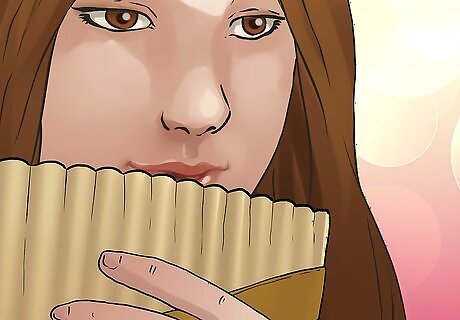
Practice frequently. The most surefire way to improve your technique is to practice playing the pan flute frequently. Playing for 30-60 minutes every day will help you grow accustomed to shaping your embouchure
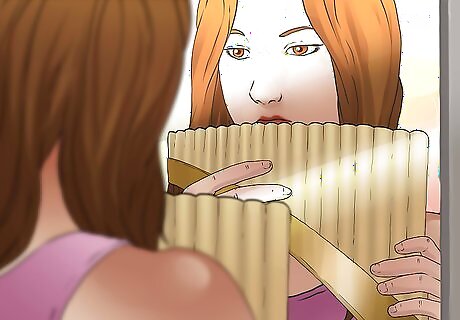
Practice in front of a mirror. Use a mirror to observe your technique as you play. Pay attention to the shape of your mouth as you play. Practice changing your embouchure to see what different tones this produces.

Play with a group of pan flutists. A good way to improve how you play the pan flute is to play with a group of people who also play. You can learn techniques from other people and they can give you feedback on your technique.
Caring for your Pan Flute

Clean your pan flute after playing. When you play your pan flute, some moisture can build up inside the tubes. After you have finished playing, swab the inside of each tube with a damp soft cloth. Allow the flute to dry before putting it away.

Store your pan flute in a padded case. Once the flute is dried after playing, store it in a cloth padded case. The cloth should be decently breathable so that any residual moisture can escape. Storing the pan flute in a case will keep it from being exposed to dust and potential damage.

Protect your pan flute from sudden temperature changes. Wood instruments are highly susceptible to changes in temperature and humidity. Try to keep your pan flute in a consistent temperature environment. Don’t leave it in a hot car, for example.
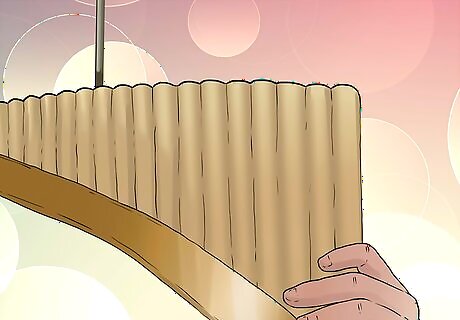
Smooth the mouthpieces. Periodically, the mouthpieces of the pan flute might become rough from frequent playing. Use a tuning rod to smooth down the mouthpieces. Rub a tuning rod across the top of the tubes; this will help smooth down any fibers that are standing up.

Repair any cracks in the tubes. Cracks and hairline fractures can alter or compromise the sound of a pan flute. Check your flute periodically for cracks or fractures. Patch them up with adhesive tape for a quick fix. Use beeswax to seal up the crack for a long-term repair. Alternately, take the pan flute to a musical instrument repair shop for professional repair.




















Comments
0 comment